Frankenstein and Caligari
Obviously not a Frankenstein movie as such, the Cabinet of Dr Caligari is a classic silent film that has cast a long shadow across the horror genre, and particularly across the Frankenstein subgenre.

I first saw Caligari as a pretentious teenager and pretended to like it. I tried to watch it again a couple of years ago, as a pretentious adult, but couldn’t get more than ten minutes in. Most recently, I watched it while half asleep on a very long train ride. That’s how to do it. The film has a deliberately dreamlike quality to it. Watching it while wide awake takes something away from it. If you’re half asleep and slightly depressed, this is the film for you.
In a little German town, an old man is telling a weird story to Francis (Frederich Freher). A woman who Francis claims is his fiancée, Jane (Lil Dagover), walks by. Francis tells the old man that he has a far stranger story to tell.
Francis and his friend Alan (Hans Heinrich von Twardowski)–both rivals for the affections of Jane Osen–go to see the fair. Meanwhile, the mysterious Dr Caligari (Werner Krauss) goes to the town clerk, after a license to show his attraction, a man called Cesare (Conrad Veidt) who is in a permanent trance. The clerk angers Caligari with his high-handedness. That night, the clerk is stabbed to death.
The next day, the friends arrive at the fair. They go to see Caligari and his somnambulist. Caligari commands Cesare to awake, and claims that Cesare can tell fortunes. Alan asks for a fortune and Cesare claims he will die before dawn. Sure enough, before dawn, Cesare stabs him to death.

Francis suspects Caligari, but his investigations turn up no proof. He sits at the window to Caligari’s caravan, and watches Cesare sleep. Or does he? Cesare breaks into the room of Jane, knife in hand. At the last moment, he does not stab her, but assaults and kidnaps her. He is chased across town, until he tires under the weight of his victim. He drops her and runs on, but soon collapses and dies.
Francis confronts Caligari. The ‘Cesare’ he has been watching is a dummy! Caligari flees. Francis pursues him to an insane asylum where he discovers that Caligari is the Director. Enlisting the aid of the asylum doctors, Francis searches Caligari’s office. He finds a book describing a mysterious mountebank in Italy in 1784 named ‘Caligari’ who killed people by willing a somnambulist named ‘Cesare’ to murder, and then putting people off the sent with a dummy of Cesare. We learn that the director of the asylum waited until he had a somnambulist under his care, then set off to duplicate the exploits of Caligari.
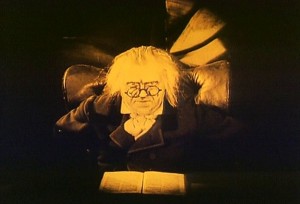
The Director is confronted but denies everything until the dead body of Cesare is brought before him. The Director goes berserk, lashing out at the doctors, who put him in a straightjacket.
We go back to Francis telling his story to the old man. The camera pulls back and we see that Francis is in the asylum! The benevolent figure of the Director does his rounds, and Francis attacks him, accusing him of being Caligari. The director claims that he now understands Francis’ madness, and believes he may be cured. Roll credits.
It’s no secret that Germany came out of WWI all kinds of messed up. That messed-up-ness took on a decidedly ugly dimension in the 1930s, when the Nazis decided that the solution to the problems caused by the disasterous World War was to try another war and get it right this time. (Spoiler: that plan didn’t work.)
But in the 1920s Germans were still trying to find somewhat less awful ways of coming to terms with what had just happened. So were other Europeans, of course, and to a lesser extent the British, Americans, Australians and New Zealanders. But the while the English speaking world was heavily involved in WWI, the vast bulk of the fighting was in Europe and the Middle East, and it was those countries who reacted most strongly to the disaster of War.
One of the after effects of the war in the realm of art, where people began picking away at the ideas of Nationalism and Militarism. Caligari comes from the Expressionist tradition, which predated the War, but which came into its own in Weimar Germany. It eschewed naturalism and realism, preferring to depict emotional truths about the world rather than physical truths. From this comes the dreamlike quality of Dr Caligari. The town in which it is set is not shown as a real, liveable place, but one exaggerated and distorted by emotional connotations. Buildings lean at odd angles, and there isn’t a square window in town. Figures of civic authority are up high–perched on high chairs or accessible by long stairways. It’s a movie about fear and power, and fear and power twists the very buildings.
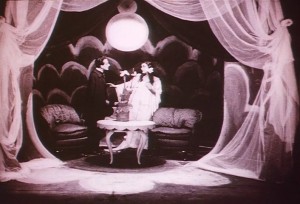
(Hmmm… The Golem, Cabinet of Dr Caligari, Metropolis, Nosferatu, M… it’s almost like fear and power were major themes in German cinema in the interwar period. But I digress.)
Schools other than Expressionism went further, deliberately attempting to subvert the idea of objectivity or any unifying principle that could bring millions together in an act of violence. Dozens of art movements popped up, flowered and vanished. But I suspect that the makers of Dr Caligari were less interested in disrupting, and more interested in understanding. Basically, how had millions of people been convinced to enter into four years of living Hell in a war which benefited basically nobody? Dr Caligari addresses that question with the metaphor of the old man, too weak and decrepit to kill anyone himself, working through his brainwashed minion. What’s worse, the old man is the Director of the institution to which the minion had been committed – an authority figure, whose duty was to care for people, instead working against everyone’s interest.
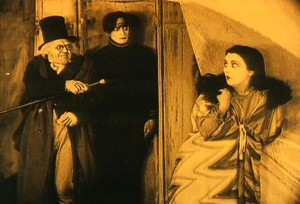
And why? What was his motivation? Well, he’s doing it because it happened before. The Director is obsessed with imitating the exploits of the real Dr Caligari in Northern Italy in 1794. Hmmm… What was happening in Northern Italy in 1794? Oh, yeah. Napoleon was conquering the place, and setting up puppet republics to do his bidding. The Director imitating Caligari becomes the Kaiser imitating Napoleon, and interchangeable Cesares are the French and German peoples, respectively.
But that interpretation hits a difficulty when we consider the framing sequence. Francis, the man who tells us all this about the Director and Caligari, is shown to be delusional. Jane is shown also to be mad. The Director actually is a benevolent authority figure. This could be read as ambiguous – did the experiences of Francis and Jane drive them mad, and thereby drive them further into the Director’s clutches? But there’s not much to support this reading. A final shot of the Director looking evil would do it, but we iris out on him looking thoughtful.
So am I going to stick with my initial reading? Yes. Because Dr Caligari a horror movie, and there’s an awful, persistent tendency in horror movies to undermine themselves just for the sake of a twist or shock ending, and I’m pretty sure that’s what happened here.
Update: Since writing this, I learned what I should have known when I first wrote it — namely that the framing sequence was not in the original script. It was tacked on later by the producers, presumably to deliberately tone down the metaphor presented in the movie.
Anyway, whether I’m right or wrong about that, I want to talk about Caligari and Frankenstein. On the plot level, there’s not a lot in common between them, though the ‘is he mad’ unreliable narrator framing sequence was used again in Curse of Frankenstein, though far less effectively.
Still, a lot of the DNA of Dr Caligari has found its way into the Frankenstein genre. The Expressionist visuals were adopted (in a toned-down sort of way) by James Whale for 1931’s Frankenstein. This was probably a good idea. While Caligari looks amazing on blurry 1920s filmstock, I suspect that the sharper filming techniques of the 1930s would make the cheap sets seem kind of like Play School.
Caligari gives the Frankenstein tradition some ideas that go far beyond Whale. The visual of the monster carrying off a woman in a white nightie comes from Caligari, and becomes as much a cliché of Frankenstein movies as of horror movies in general. The angry mob that pursues Cesare, on the other hand, became a more specifically Frankensteinian trope.
More important is the idea of the monster having a controller. The Monster – after James Whale is done with him, anyway – is powerful but not all that bright, and lacks motivation beyond revenge on Frankenstein. What’s more, we want to sympathise with the Monster. All of these factors tend to limit the Monster’s role as a villain who can drive the plot.
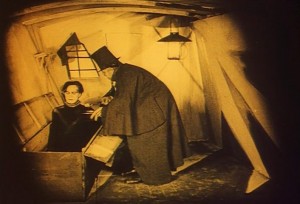
‘I don’t wanna get gack in the gox!’
From Dr Caligari, Frankenstein movies get the idea of the Monster working in partnership. While the Monster himself is just the big, dumb patchwork zombie we all know and love, he falls easily under the influence of a malevolent manipulator. The Monster’s terrifying body is controlled by the villain’s terrifying mind. But as in the case of Caligari and Cesare, the master’s power is not absolute. The Monster is capable of reasserting his sympathetic nature by turning on its master.
Bride of Frankenstein’s Dr Pretorious is the first example of what I think of as the ‘Caligari Character’, but by no means the last. Ygor take over his function of manipulating the Monster all through Son of Frankenstein and Ghost of Frankenstein. In House of Frankenstein, Boris Karloff himself plays an extremely Caligarian character — a scientist who disguises himself as a sideshow mountebank, who manipulates the (boxed) Dracula and who attempts to use the Monster to further his schemes. Hammer’s Evil of Frankenstein give us the character of Zoltan, a sideshow hypnotist who mesmerises the Monster into attacking local officials who offended him, and you could hardly make that any more Calagari-ish if you tried. There are other examples – Polidori in Frankenstein: the True Story, and Dr Frankenstein himself in I was a Teenage Frankenstein.
But the influence is not all one way. I strongly suspect that Dr Caligari borrows from earlier versions of the Frankenstein story. In particular, check out the scene in which Caligari first wakes Cesare, and consider of these lines from Mary Shelley’s introduction to the 1831 edition of Frankenstein: I saw the pale student of unhallowed arts kneeling beside the thing he had put together… He sleeps; but he is awakened; he opens his eyes; behold the horrid thing stands at his bedside, opening his curtains, and looking on him with yellow, watery, but speculative eyes.

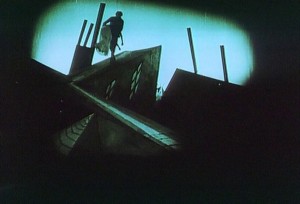
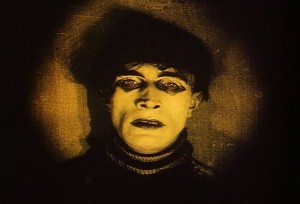


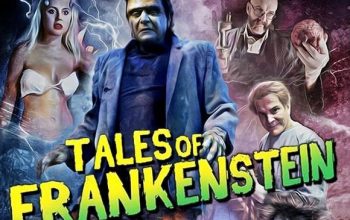
im so sad
Aw. What about?